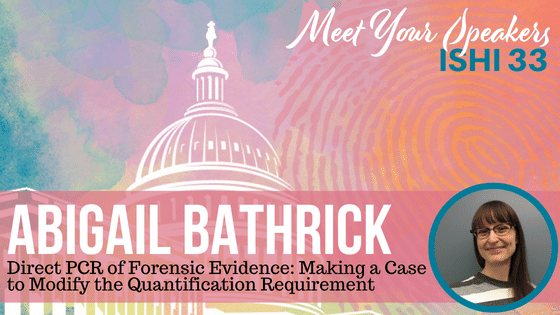Direct polymerase chain reaction (PCR) is a method in which a swab or substrate punch is added to an amplification reaction without prior extraction or quantification and has been shown to improve DNA profiles from some types of low-yield DNA evidence samples. Direct PCR maximizes the amount of DNA template in a reaction by eliminating the DNA loss that occurs during DNA extraction, quantification, and concentration. It can also reduce laboratory errors, contamination events, sample processing time, and costs.
Although laboratories in the United States can use direct PCR for reference samples, they are unable to implement it for forensic evidence samples due to FBI Quality Assurance Standard 9.4, which requires all unknown forensic samples to undergo human-specific DNA quantification prior to amplification of short tandem repeat (STR) loci.
In her presentation at ISHI 33 this year, Abigail will demonstrate the value and effectiveness of direct PCR for forensic DNA evidence samples and emphasize the importance of reevaluating guidelines as technologies advance and new data become available. This presentation will also summarize the history of direct PCR, the advantages and disadvantages of its use for forensic DNA evidence samples, and current and ongoing research findings. We chatted with her to learn which samples benefit from direct PCR, long term benefits to labs being allowed to implement this into their casework, and advice for those just starting out in the field.
Can you briefly describe when and how direct PCR methods began to be adopted in forensic laboratories?
Direct PCR is reliable, efficient, and cost effective for high-throughput processing of reference and database samples and has been validated for such samples for years in laboratories around the world. Application of direct PCR to evidentiary-type samples began in 2010 when Linacre et al. evaluated direct PCR of touch DNA on fabrics. Since that time, many research papers and several review articles examining direct PCR with forensic samples have been published.
Why has direct PCR not been used for casework samples up to this point?
In the United States, FBI Quality Assurance Standard 9.4 requires all unknown forensic samples to undergo human-specific DNA quantification prior to STR amplification. Although direct PCR of casework samples has been validated in some laboratories outside of the US, many practitioners remain skeptical of its use due to concerns regarding sample consumption, the elimination of early mixture detection during quantification, and increased sensitivity leading to more complex mixtures.
Are there certain samples for which this method works better than others? Are there times when this method should definitively not be used?
Direct PCR has been successful on a wide range of biological sample types and commonly encountered substrates. Direct PCR of casework bloodstains may be a good starting point, as this method has already been validated for casework by Forensic Science Service Tasmania [Gray et al., 2014]. If using an unmodified PCR method, direct PCR is not currently suitable for low-yield touch DNA samples collected from substrates containing known PCR inhibitors.
What are the long-term benefits to laboratories being allowed to implement direct PCR in their casework samples?
The main benefits are reduced processing time and cost. Estimates indicate savings of 3–4 hours hands-on time for laboratory personnel and approximately 25% in processing costs.
What tips would you give to someone who is just starting out in the field of forensics, or what is the best advice that you’ve received?
For students considering going into forensics, I recommend talking to people already working in the field. Internships and conferences are a great way interact with forensic professionals.
If you had to pick one thing, what do you enjoy most about your job?
As a research scientist, I like having the opportunity to evaluate new technologies.
If you could have dinner with anyone (dead or alive), who would it be? Why?
David Attenborough – I think he would have the most interesting stories from a lifetime of traveling and presenting nature documentaries.
If you’ve attended ISHI in the past, what do you most enjoy about coming to the conference? If you haven’t, what are you most looking forward to?
It’s well organized, and I like the focus on DNA.
What’s one thing that others may not know about you?
I read over a hundred novels last year.
WOULD YOU LIKE TO SEE MORE ARTICLES LIKE THIS? SUBSCRIBE TO THE ISHI BLOG BELOW!
SUBSCRIBE NOW!


